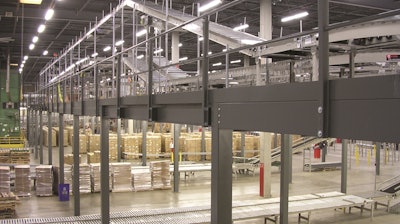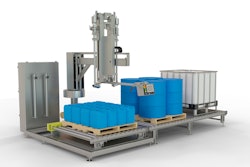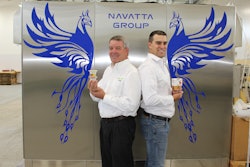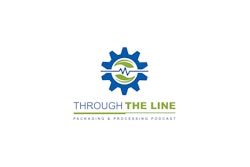The availability of same- and next-day delivery (largely driven by online retailers like Amazon) has altered customer expectations regarding order fulfillment times, even within the food and beverage industry. In the past, companies would invest in larger, new facilities to meet rising consumer demands. In an era where space is at a premium, companies are resolving the footprint problem by capitalizing on unused vertical space by installing industrial mezzanines.
When a successful essential oils supplier in the Western United States found themselves struggling to keep pace with market demands, it knew that facility layout was a barrier to growth. While investigating potential solutions, the company realized that building a new facility would mean moving away from the employees and community that had made the business a success. Through a partnership with a supply chain consultant, the essential oils supplier found the answer in a new mezzanine measuring 136 x 55 ft.
“Many do not realize that mezzanines are a cost-effective way to maximize an existing building’s potential,” said Dave Milner, Vice President of Sales and Marketing a Wildeck, Inc., a mezzanine manufacturer. “With ceiling heights in excess of 30 ft, most warehouses and distribution centers can easily accommodate a single or multi-leveled mezzanine and achieve the square footage necessary for expanded operations.”
Maximized resources
When a complete packaging solution provider consolidated two locations (totaling 212,000 sq ft) into one modern facility (totaling 185,000 sq ft), it knew that addressing the reduction in total building space would be a unique challenge. After researching some options, it became evident that the most economical route was to utilize the building’s existing overhead space and install a mezzanine. In addition to resolving the company’s square footage dilemma, the mezzanine functioned as a centralized location for tool and material storage. As a result of the new, centralized storage location, the company noticed an increase in efficiency when switching between orders and a decrease in the amount of time spent looking for materials and waiting for replacement tools to arrive.
According to Milner, “Mezzanines are a great way to enhance a facility’s organization. In addition to making it easier to quickly locate necessary tools and equipment, mezzanines create a safe storage space for a facility’s more costly tool and equipment resources.”
Space to automate
A leading, multi-brand technology solutions provider found themselves questioning how to make the most efficient use of its new facility’s 500,000 sq ft. Built to accommodate the shipment of some 60,000 outbound cases of products daily, it was determined early on that automated processes would play a pivotal role in helping the company achieve its order fulfillment goals. To achieve a well-organized, flow-through design, the facility’s seven miles of roller conveyor belts were stationed on two custom-designed, multi-level mezzanines. By putting the automation equipment on mezzanines in the building’s unused vertical space, the company was able to keep the ground level free for more critical tasks and achieve its daily shipment goal.
“Given the multitude of benefits that automation provides, it’s not surprising that many industries are anxious to implement these solutions,” said Milner. “However, many struggle with how to fit the new equipment into their current facility layout. When constructed with heavy-duty steel and engineered properly, a mezzanine can safely support the weight of automation equipment, leaving the ground floor unobstructed for employee use.”
Industrial mezzanines are flexible and can be engineered to work in a cooler or freezer and are adaptable to the strictest equipment guidelines and specifications. With an array of application possibilities, industrial mezzanines can provide food and beverage companies with a cost-effective way to increase their facility’s footprint.




















